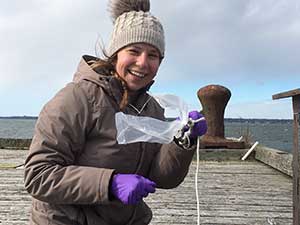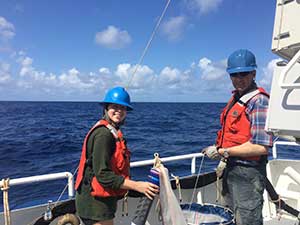![]()
Detection Tools
Environmental Engineering: Develop passive samplers for the detection and bioaccumulation of PFAS in water and porewater
Lead: Rainer Lohmann, URI Graduate School of Oceanography (GSO); Key Personnel: Laurel Schaider, Silent Spring Institute
The central hypothesis is that passive sampling can be used to detect PFAS and their precursors in water and porewater.

 This project is developing, validating, and deploying novel passive samplers for the detection of poly- and perfluoroalkyl substances (PFAS) in water and porewater (water in the sediment). At contaminated sites, as the extent of a PFAS plume is investigated, benefits of field-validated passive sampling approaches include ease of handling, shipping, and analysis; reduced potential for contamination; and lower detection limits that will be needed as regulatory agencies adjust their references doses.
This project is developing, validating, and deploying novel passive samplers for the detection of poly- and perfluoroalkyl substances (PFAS) in water and porewater (water in the sediment). At contaminated sites, as the extent of a PFAS plume is investigated, benefits of field-validated passive sampling approaches include ease of handling, shipping, and analysis; reduced potential for contamination; and lower detection limits that will be needed as regulatory agencies adjust their references doses.
This project will:
- Develop a porewater fiber for measuring PFAS concentrations.
- Collaborate with U.S. Environmental Protection Agency to determine PFAS accumulation in bivalves (e.g., mussels and oysters), and compare these results to the novel passive samplers.
- Validate PFAS passive sampling tools.
Sites for field validation and application are located on Cape Cod, MA, including in ponds near Joint Base Cape Cod, where groundwater is contaminated by aqueous film forming foams. Researchers are engaging residents and stakeholders to address concerns about long-range PFAS transport and characterizing the extent of impacted ponds, creeks, and estuaries.

